Tàu đến cảng Ushuaia (Argentina)
Ushuaia nằm ở mỏm của Thái Bình Dương và Đại Tây Dương là thành phố gần nam cực nhất
trời hừng đông
núi tuyết sau lưng
uống cà phê ngắm cảnh, sắp đến cảng Ushuaia, cảnh núi tuyết đẹp tuyệt
Chim Albatross dạn quá, đến gần tàu kiếm ăn
chuyện trò với ông bà người Mỹ đã di cruise 38 lần
vào cảng Ushuaia Á căn đình
tourist information center
quang cảnh gần bến tàu
Eva Perón
From Wikipedia, the free encyclopedia
María Eva Duarte de Perón (7 May 1919 – 26 July 1952) was the second wife of Argentine President Juan Perón (1895–1974) and served as the First Lady of Argentina from 1946 until her death in 1952. She is usually referred to as Eva Perón (Spanish: [ˈeβa peˈɾon]), or by the affectionate Spanish language diminutive Evita.
She was born in the rural village of Los Toldos, in the Pampas, as the youngest of five children. At 15 in 1934, she moved to the nation's capital of Buenos Aires to pursue a career as a stage, radio, and film actress. She met Colonel Juan Perón there on 22 January 1944 during a charity event at the Luna Park Stadium to benefit the victims of an earthquake in San Juan, Argentina. The two were married the following year. Juan Perón was elected President of Argentina in 1946; during the next 6 years, Eva Perón became powerful within the pro-Peronist trade unions, primarily for speaking on behalf of labor rights. She also ran the Ministries of Labor and Health, founded and ran the charitable Eva Perón Foundation, championed women's suffrage in Argentina, and founded and ran the nation's first large-scale female political party, the Female Peronist Party.
In 1951, Eva Perón announced her candidacy for the Peronist nomination for the office of Vice President of Argentina, receiving great support from the Peronist political base, low-income and working-class Argentines who were referred to as descamisados or "shirtless ones". However, opposition from the nation's military and bourgeoisie, coupled with her declining health, ultimately forced her to withdraw her candidacy.[1] In 1952, shortly before her death from cancer at 33, Eva Perón was given the title of "Spiritual Leader of the Nation" by the Argentine Congress.[2][3][4] Eva Perón was given a state funeral upon her death, a prerogative generally reserved for heads of state.
trừu nướng thơm quá !
đặc sản King crab và bia Beagle của vùng Ushuaia ngon tuyệt
no nê rồi, tiếp tục thăm viếng
chó thấy khắp nơi
nụ hoa pavot popy thuốc phiện sắp nở
Nhà thờ dòng Don Bosco
có ai muốn leo núi tuyết không? gần lắm
đâu còn thời gian, sắp tới giờ tàu rời bến rồi !
đi về hướng cảng thôi! cảnh đẹp lắm . mây nước chim cò
đến giờ trở về tàu rồi
cảnh thiên nhiên với núi tuyết vĩnh cửu tuyệt đẹp nhìn thật relax không chán
Khi tàu đi qua vùng này suốt 2 ngày chung quanh là những dãy núi tuyết với nhiều Glacer nhìn thật hùng vĩ thanh thản giống như đi Alaska
Au revoir Ushuaia
***************************
Ushuaia
Situated on the Beagle Strait, Ushuaia is the largest city in Argentine Tierra del Fuego,
and arguably the southernmost city in the world. In the past, the town
has been a missionary base, penal colony and naval base for the
Argentine navy. Ushuaia is now a major tourist town, complete with
casinos and nice restaurants, and commonly used as a base for hiking,
winter sports and cruises to Antarctica.
Understand
In the late 19th century, the land that is now called Ushuaia was
inhabited entirely by Yamana Indians and a handful of missionaries. At
the time of writing (October 2005), there is allegedly one pure-blooded
native-speaking Yamana Indian left. An excellent book on the history of
the Yamana and their demise is The Uttermost Part of the Earth by
E. Lucas Bridges, the son of one of the early missionaries. His father,
Thomas Bridges, documented what he could of the Yamana language and
found that it had a far larger vocabulary than the English language.
Darwin, who famously sailed through the Beagle Channel, thought that the
Yamana, were "the missing link".
Today the town is growing fast as a result of increased tourism
since the 2002 economic crash. The government has encouraged this growth
by designating Tierra del Fuego a virtually tax-free zone to encourage
people to settle (many of the inhabitants of today's Ushuaia come from
Chaco, in the north of Argentina). The cost of living however, is
relatively high as all goods have to be transported long distances,
usually by container ship. Inflation is rampant even in USD terms,
expect your guide-book to be well out of date and prices to be double or
triple a few years ago.
Climate-wise, Ushuaia is warmer than many assume; although
(arguably) the southernmost city in the world, it is no further south
than Belfast is north, and temperatures rarely drop below -10°C. However, summers tend not to climb much above +12°C and, as in all of Patagonia, strong winds add a significant wind chill factor.
********************************************************
Ushuaia
From Wikipedia, the free encyclopedia
For other uses, see Ushuaia (disambiguation).
| Ushuaia | ||
|---|---|---|

(From top to bottom; from left to right) View of Ushuaia from the harbor; Les Eclaireurs Lighthouse; Falklands War Memorial; Tierra del Fuego, Antártida e Islas del Atántico Sur government building and the port.
| ||
| ||
| Motto: "Ushuaia, fin del mundo, principio de todo" (Spanish) "Ushuaia, end of the world, beginning of everything" | ||
| Coordinates: 54°48′S 68°18′W | ||
| Country | ||
| Province | ||
| Department | Ushuaia | |
| Founded | 12 October 1884 | |
| Founded by | Commodore Lasserre ARA | |
| Government | ||
| • Type | Municipality | |
| • Mayor | Federico Sciurano | |
| Area | ||
| • Total | 23 km2 (9 sq mi) | |
| Elevation | 23 m (75 ft) | |
| Population (2010 Census[1]) | ||
| • Total | 56,956 | |
| • Density | 2,500/km2 (6,400/sq mi) | |
| Time zone | ART (UTC−3) | |
| CPA Base | V 9410 | |
| Area code(s) | +54 2901 | |
| Climate | Cfc | |
| Website | Official website | |
Ushuaia (/uːˈʃwaɪ.ə/; Spanish pronunciation: [uˈswaʝa]) is the capital ofTierra del Fuego, Antártida e Islas del Atlántico Sur Province,Argentina. It is commonly regarded as the southernmost city in the world.[2][3] Ushuaia is located in a wide bay on the southern coast ofIsla Grande de Tierra del Fuego, bounded on the north by the Martial mountain range, and on the south by the Beagle Channel. It is the onlymunicipality in the Department of Ushuaia, which has an area of 9,390 km2 (3,625 sq mi).
Contents
[hide]History[edit]
The Selk’nam Indians, also called the Ona, first arrived in Tierra del Fuego about 10,000 years ago. The southern group of the Selk’nam, the Yaghan (also known as Yámana), occupied what is now Ushuaia, living in continual conflict with the northern inhabitants of the island.[4]
For much of the latter half of the 19th century, the eastern portion of Tierra del Fuego was populated by a substantial majority of nationals who were not Argentine citizens, including a number of British subjects. Ushuaia was founded informally by British missionaries, following previous British surveys, long before Argentine nationals or government representatives arrived there on a permanent basis. The British ship HMS Beagle, under the command of Captain Robert FitzRoy, first reached the channel on January 29, 1833, during its maiden voyage surveying Tierra del Fuego.[5] The city was originally named by early British missionaries[6] using the native Yámana name for the area. Much of the early history of the city and its hinterland is described in Lucas Bridges’s book Uttermost Part of the Earth (1948). The name Ushuaia first appears in letters and reports of the South American Mission Society[6] in England. The British missionary Waite Hockin Stirling[7] became the first European to live in Ushuaia when he stayed with the Yámana people between 18 January and mid-September 1869. In 1870 more British missionaries arrived to establish a small settlement. The following year the first marriage was performed. During 1872, 36 baptisms and 7 marriages and the first European birth (Thomas Despard Bridges) in Tierra del Fuego were registered.[8] The first house constructed in Ushuaia was a pre-assembled 3 room home prepared in the Falkland Islands in 1870 for Reverend Thomas Bridges. One room was for the Bridges family, a second was for a Yámana married couple, while the third served as the chapel.[9]
During 1873, Juan and Clara Lawrence, the first Argentine citizens to visit Ushuaia, arrived to teach school. That same year Julio Argentino Roca, who later served as Argentine President twice, promoted the establishment of a penal colony for re-offenders, modeled after one in Tasmania, Australia, in an effort to secure permanent residents from Argentina and to help establish Argentine sovereigntyover all of Tierra del Fuego.[10][11] But only after the Boundary treaty of 1881 between Chile and Argentina did formal efforts get under way to establish the township and its prison.
During the 1880s, many gold prospectors came to Ushuaia following rumors of large gold fields, which proved to be false.[12][13] On the 12th of October 1884, as part of the South Atlantic Expedition, Commodore Augusto Lasserre established the sub-division of Ushuaia,[14] with the missionaries and naval officers signing the Act of Ceremony. Don Feliz M Paz was named Governor of Tierra del Fuego and in 1885 named Ushuaia as its capital. In 1885 the territory police was organized under Antonio A. Romero with headquarters also in Ushuaia. But it was not until 1904 that the Federal Government of Argentina recognized Ushuaia as the capital of Tierra del Fuego.[15]
Ushuaia suffered several epidemics, including typhus, pertussis, and measles, that decimated the native population. But because the Yámana were not included in census data, the exact numbers lost are not known. The first census was held in 1893, which recorded 113 men and 36 women living in Ushuaia. The prison was formally announced in an Executive order by the then-Acting President Roca in 1896.[8] By 1911 the Yámana had all practically disappeared, so the mission was closed.[16] The population grew to 1,558 by the 1914 census.
In 1896 the prison received its first inmates, mainly re-offenders and dangerous prisoners transferred from Buenos Aires, but also some political prisoners. A separate military prison opened in 1903 at the nearby Puerto Golondrina. The two prisons merged in 1910, and that combined complex still stands today.[7][17] Thus, during the first half of the 20th century, the city centered around the prison built by the Argentine government to increase the Argentine population and to ensure Argentine sovereignty over Tierra del Fuego.[10][11] The prison was intended for repeat offenders and serious criminals, following the example of the British in Tasmania and the French in Devil's Island.[11] Escape from Tierra del Fuego was similarly difficult, although two prisoners managed to escape into the surrounding area for a few weeks.[10] The prison population thus became forced colonists and spent much of their time building the town with timber from the forest around the prison. They also built a railway to the settlement,[18] now a tourist attraction known as the End of the World Train (Tren del Fin del Mundo), the southernmost railway in the world.
The prison operated until 1947, when President Juan Perón closed it by executive order in response to the many reports of abuse and unsafe practices.[7][17] Most of the guards stayed in Ushuaia, while the prisoners were relocated to other jails farther north. After the prison closed, it became a part of the Base Naval Ushuaia (Spanish), functioning as a storage and office facility until the early 1990s.[19] Later it was converted into the current Museo Maritimo de Ushuaia.[20]
Geography[edit]
Main article: The southernmost city in the world
Further information: Southernmost settlements
Ushuaia has long been described as the southernmost city in the world.[2][3] While there are settlements farther south, the only one of any notable size is Puerto Williams, a Chilean settlement of some 2,000 residents.[21] As a center of population, commerce, and culture, and as a town of significant size and importance,[22] Ushuaia however clearly qualifies as a city. A 1998 article in the newspaper Clarín[23] reported that the designation "Southernmost city in the world" had been transferred to Puerto Williams by a joint committee from Argentina and Chile, but this was denied by Argentine authorities,[24][25] and the Secretariat of Tourism of Argentina continues to use the slogan in official documentation and web sites.[26]
Climate[edit]
Ushuaia has a subpolar oceanic climate. In the Köppen climate classification this is typically represented as a temperate climate (Cfc). While Ushuaia meets the technical definition of Köppen's polar ET tundra climate (as every monthly average temperature is below 10.0 °C (50.0 °F)), it has mild winters and 3 months above 9 °C due to the temperate influence of the ocean. Vegetation around the city thus does not resemble typical tundra but is instead heavily forested. Temperatures at the Ushuaia – Malvinas Argentinas International Airport average 1.3 °C (34.3 °F) in the coolest month (July), and 9.6 °C (49.3 °F) in the warmest month (January).[27]The record low is −21 °C (−6 °F) in July, and the record high is 29.5 °C (85 °F) in January.[28] On average the city experiences 146 days of precipitation a year, with many cloudy and foggy days, averaging 206 cloudy days a year.[29] This results in Ushuaia receiving an average of 3.93 hours of sunshine per day (an annual total of 1,434 hours) or about 30.2% of possible sunshine.[28] Despite receiving only 529.7 millimetres (21 in) average annual precipitation, Ushuaia is very humid with an average humidity of 77%.[27] A similar climate is found in Puerto Williams (Chile), Tórshavn (Faroe Islands), Unalaska (Alaska), Reykjavík (Iceland) and Stanley(Falkland Islands).
Summers tend to be cloudy and windy, with maximum temperatures averaging around 14 °C (57 °F) during the day and about 5 °C (41 °F) at night.[29] Temperatures of 20 °C (68 °F) or more occur only on a handful of days, and night frost is always possible, as well as days below 10.0 °C (50 °F). Temperatures gradually diminish during the autumn, to reach maximum temperatures of about 4.5 °C (40 °F) and minimum temperatures of −1.4 °C (29 °F) in winter, with frequent snow, sleet and rain showers.[29] Some winters may bring extended periods of frost and snow, whereas other winters might just bring snowstorms followed by thaws. Temperatures then very slowly recover during the spring, but snow showers and frost are a common occurrence until the beginning of the summer in December, and they might occur even in midsummer.
The southwestern winds make the outer islands wetter, reaching 1,400 mm (55 in) at Isla de los Estados (Staten Island). Because temperatures are cool throughout the year, there is little evaporation. Snow is common in winter and regularly occurs throughout the year. Ushuaia occasionally experiences snow in summer (from November to March). Due to its high southern latitude, the city's climate is influenced by Antarctica, and the duration of daylight varies significantly, from more than 17 hours in summer to just over 7 hours in winter.
| [hide]Climate data for Ushuaia Airport (1961–1990, extremes 1901–present)[a] | |||||||||||||
|---|---|---|---|---|---|---|---|---|---|---|---|---|---|
| Month | Jan | Feb | Mar | Apr | May | Jun | Jul | Aug | Sep | Oct | Nov | Dec | Year |
| Record high °C (°F) | 29.5 (85.1) | 28.9 (84) | 25.6 (78.1) | 22.2 (72) | 20.3 (68.5) | 19.0 (66.2) | 17.5 (63.5) | 18.0 (64.4) | 22.3 (72.1) | 21.2 (70.2) | 26.3 (79.3) | 29.0 (84.2) | 29.5 (85.1) |
| Average high °C (°F) | 13.9 (57) | 13.7 (56.7) | 12.2 (54) | 9.6 (49.3) | 6.5 (43.7) | 4.6 (40.3) | 4.2 (39.6) | 5.6 (42.1) | 8.2 (46.8) | 10.5 (50.9) | 12.1 (53.8) | 13.4 (56.1) | 9.5 (49.1) |
| Daily mean °C (°F) | 9.6 (49.3) | 9.3 (48.7) | 7.7 (45.9) | 5.7 (42.3) | 3.2 (37.8) | 1.7 (35.1) | 1.3 (34.3) | 2.2 (36) | 4.1 (39.4) | 6.2 (43.2) | 7.8 (46) | 9.1 (48.4) | 5.7 (42.3) |
| Average low °C (°F) | 5.4 (41.7) | 5.3 (41.5) | 3.9 (39) | 2.3 (36.1) | 0.1 (32.2) | −1.4 (29.5) | −1.7 (28.9) | −1 (30) | 0.5 (32.9) | 2.3 (36.1) | 3.6 (38.5) | 4.9 (40.8) | 2.0 (35.6) |
| Record low °C (°F) | −2.0 (28.4) | −4.0 (24.8) | −4.3 (24.3) | −7.3 (18.9) | −20.2 (−4.4) | −18.2 (−0.8) | −21.0 (−5.8) | −19.6 (−3.3) | −10.6 (12.9) | −6.1 (21) | −6.0 (21.2) | −3.7 (25.3) | −21.0 (−5.8) |
| Averageprecipitationmm (inches) | 39.0 (1.535) | 45.2 (1.78) | 52.3 (2.059) | 56.1 (2.209) | 53.4 (2.102) | 48.3 (1.902) | 36.4 (1.433) | 45.2 (1.78) | 41.7 (1.642) | 35.0 (1.378) | 34.6 (1.362) | 42.5 (1.673) | 529.7 (20.854) |
| Average precipitation days(≥ 0.1 mm) | 14 | 13 | 14 | 13 | 12 | 12 | 11 | 12 | 12 | 12 | 12 | 14 | 151 |
| Average snowy days | 0.3 | 0.1 | 2 | 2 | 5 | 8 | 7 | 9 | 7 | 5 | 3 | 1 | 49.4 |
| Averagerelative humidity (%) | 75 | 76 | 78 | 80 | 81 | 82 | 82 | 80 | 76 | 73 | 72 | 74 | 77 |
| Mean monthlysunshine hours | 167.4 | 146.9 | 133.3 | 102.0 | 68.2 | 42.0 | 55.8 | 83.7 | 123.0 | 164.3 | 180.0 | 167.4 | 1,434 |
| Percentpossible sunshine | 32.0 | 34.5 | 33.5 | 31.5 | 25.7 | 18.5 | 22.5 | 27.5 | 34.0 | 37.5 | 37.0 | 28.5 | 30.2 |
| Source #1: NOAA,[27] Secretaria de Mineria (extremes and sun, 1901–1990),[28] Oficina de Riesgo Agropecuario (extremes 1970–present)[30] | |||||||||||||
| Source #2: Servicio Meteorológico Nacional (precipitation days)[31] UNLP (snowfall data)[32] | |||||||||||||
Economy[edit]
The main economic activities are fishing, natural gas and oil extraction[citation needed],sheep farming and ecotourism.
Tourism[edit]
Tourist attractions include the Tierra del Fuego National Park and Lapataia Bay. The park can be reached by highway, or via the End of the World Train (Tren del Fin del Mundo) from Ushuaia. The city has a museum of Yámana, English, and Argentine settlement, including its years as a prison colony. Wildlife attractions include local birds, penguins, seals, and orcas, many of these species colonizing islands in the Beagle Channel. There are daily bus and boat tours to Harberton, the Bridges family compound. Tours also visit the Les Eclaireurs Lighthouse. Les Eclaireurs is sometimes confused with the "Lighthouse at the End of the World" (Faro del fin del mundo) made famous by Jules Verne in the novel of the same name; but the latter lies some 200 mi (320 km) east of Ushuaia on Isla de los Estados (Staten Island).
Manufacturing[edit]
Ushuaia's industrial sector, led by the Grundig Renacer electronics factory, is among the largest in Patagonia.
Arts and culture[edit]
Since 2007 Ushuaia has hosted the Bienal de Arte Contemporáneo del Fin del Mundo (Biennial of Contemporary Art at the End of the World), created and organized by the Patagonia Arte & Desafío Foundation under the rubric "South Pole of the Arts, Sciences, and Ecology". The Bienal has gathered over one hundred artists from five continents addressing the motto "think at the End of the World that another world is possible". As a pedagogical project it encourages students at all levels to "think about a better world".[citation needed]
Sports[edit]
As in most of Argentina, football is a popular sport in Ushuaia, and in 2010 the TV show FIFA Mundial did a story about the sport's development in this locality.
Ice Hockey[edit]
A popular sport in Ushuaia is ice hockey, and low temperatures all year long make the city a perfect spot for practicing it outdoors. In 2010 the city opened an outdoor short track and ice hockey Olympic-Size Ice rink (30 x 60 meters),[33] the first of its kind in South America. After this Argentina became the first South American nation to be upgraded from affiliate to associate member status of the International Ice Hockey Federation (IIHF).[34]
Since 2005 the Municipality of Ushuaia and the Argentinean Ice Hockey Federation (FAHH) organize the yearly End of the World Cup (Copa del Fin del Mundo) that has gathered ice hockey teams from Ushuaia, Buenos Aires, Punta Arenas andSao Paulo and includes seven different competitions: one for men, one for women, four junior categories and an international tournament.[35]
Skiing[edit]
Several ski areas are located near Ushuaia including Glacier El Martial (on Martial Mountains) and Cerro Castor. Opened in 1999,[36] Cerro Castor is the southernmost full-fledged ski resort in the world.[37][38] On Cerro Castor, it is possible to ski just 200 m (660 ft) above sea level. The summit reaches an elevation of 1003 meters (3468 ft) above sea level, and consistently cool temperatures allow the longest skiing season in South America. Winter temperatures fluctuate between 0° and −5 °C (32 to 23 °F). It has ten elevation facilities and 28 ski trails for all skill levels. There are cafeterias, mountain huts, a ski school, a first aid room and a forest of beech.[39] Snowboarding, sledding, and snowshoeing are also available at Cerro Castor, in addition to alpine skiing.[40] It is located on the southern side of Cerro Krund,[41] 27 km (17 mi) north of Ushuaia. The ski season is typically between June through October. In 2012 Cerro Castor hosted the FIS Freestyle Slopestyle World Cup, organized by the International Ski Federation (FIS),[42] and in 2015 it hosted the Interski Congress and World Cup, organized by the International Ski Instructors Association, which was its first ever event in the Southern Hemisphere.[43]
The glacier is popular even during the summer months, when the chairlift operates in both directions. Hiking trails lead from the city's edge to the base of the glacier, which has retreated considerably over the past century, as shown in photographs on display at the Antarctic Museum of Ushuaia.[44]
The Valley of Tierra Mayor and the Francisco Jerman Nordic Ski Area, located 20 km and 5 km away from Ushuaia respectively, are popular Cross-Country venues. Since 1986 Tierra Mayor hosts the annual Marchablanca, a 21 km traditional race organized by the Club Andino Ushuaia,[45] and the Ushuaia Loppet, a full distance marathon that is one of the 20 members of the Worldloppet Ski Federation. Usually this race starts the Federation's Marathon Series in august.[46]
In October 2014 the Argentine Olympic Committee (COA) revealed the plan to use the 2018 Summer Youth Olympics, to be held in Buenos Aires, as the launchpad for a bid in the near future. The Committee identified Argentina's south-eastern region of Patagonia, which comprises the southern section of the Andes mountains, as a possible location to host the Winter Games.[47] In 2010 it was suggested that Ushuaia would be the main option for a bid.[48]
Government[edit]
The city government consists of the three-member Board of Selectmen, a Representative Town Meeting (RTM), a Board of Finance, a Board of Education, a Planning and Zoning Commission (TPZ), and many other politically appointed commissions, boards, and committees. The current First Selectman is Chris Paul (D).[16]
Education[edit]
Ushuaia has twelve secondary schools, four of which also provide adult education.[49][50] The Colegio Nacional de Ushuaia[51] is one of the youngest schools in the city and it was modeled after the Colegio Nacional de Buenos Aires. Another important secondary school is Colegio Diocesano Monseñor Miguel Ángel Alemán, which takes its name after the Monsignor of the same name.
The National University of Patagonia San Juan Bosco[52] operates a campus in Ushuaia, with Faculties of Engineering,Economics and Humanities, and Social Sciences.
The National University of Tierra del Fuego, inaugurated in 2010, has its headquarters in Ushuaia.
Media[edit]
Television[edit]
Newspapers[edit]
There are two main newspapers, El Diario del Fin del Mundo[55] and El Diario La Prensa,[56] plus several other minor publications.
Transportation[edit]
Air[edit]
Ushuaia receives regular flights at Ushuaia – Malvinas Argentinas International Airport from El Calafate, Buenos Aires and Santiago, Chile.
Sea[edit]
In addition to being a vacation destination for local and international tourists, Ushuaia is also the key access point to the Southern Ocean, including subantarcticislands such as South Georgia and the South Sandwich Islands and Antarctic islands such as the South Orkney Islands and the South Shetland Islands. Its commercial pier is the major port of departure in the world for tourist and scientific expeditions to the Antarctic Peninsula.[citation needed] Cruise ships visiting the Falkland Islands (referred to by Argentinians as Islas Malvinas) and Antarctica dock at the port, as well as Princess Cruises, Holland America Line, and Celebrity Cruises, which transit between Valparaíso, Chile, to Buenos Aires and beyond. Antarpply Expeditions, Global Maritime, Hurtigruten, Lindblad Expeditions, Orient Lines, Quark Expeditions, Regent Seven Seas Cruises, and other passenger and freight lines provide regularly scheduled services between Ushuaia and local seaports and settlements. Australis Cruises provides regular service between Ushuaia and Punta Arenas from September to April. Tourists can also visit Cape Horn (in Chilean waters) by boat or helicopter.
Road[edit]
The southern terminus of the Pan-American Highway, which is also the southern end of Argentina National Route 3, is located in Tierra del Fuego National Park.
Health care[edit]
Located at the corner of Avenida 12 de Octubre and Maipú, the Hospital Gobernador Ernesto M. Campos[57] is one of the big health care centers in Ushuaia; the other one is private and it is called Clínica San Jorge.
Ecology[edit]
- Flora
Ushuaia is surrounded by Magellanic subpolar forests. On the hills around the town, the following indigenous trees are found: Drimys winteri (Winter's bark), Maytenus magellanica (Hard-log Mayten) and several species of Nothofagus(Southern Beech). Trees in Ushuaia tend to follow the wind direction, and are therefore called "flag-trees", for their uni-directional growth pattern.
Filmography[edit]
Ushuaïa, le magazine de l'Extrême was the name of a television program, presented by Nicolas Hulot and broadcast on the French TV channel TF1 from September 1987 to June 1995.[citation needed] The show is known in English as Ushuaia: The Ultimate Adventure, and this language's version was hosted by Perri Peltz and was shown on NBC, CNBC, and international affiliates of the Discovery Channel.[citation needed]. The city was also featured on the American CBS reality television showThe Amazing Race in the fourth leg of Season 11.
In 2014, BBC car program Top Gear visited Ushuaia at the conclusion of their "Patagonia Special", with the intent of constructing a stadium and playing a game of car football there. Before they could do so, however, they were chased out of the city (and subsequently across the border into Chile) by mobs of people angered by an apparent reference to theFalklands War encoded in the registration plate of presenter Jeremy Clarkson.
Several scenes in the 2015 film The Revenant, directed by Alejandro González Iñárritu, were shot in Ushuaia from July through November, 2014.[58][59][60]
Same-sex marriage[edit]
Further information: Same-sex marriage in Argentina
On December 29, 2009, the first same-sex couple to marry in Latin America were married in Ushuaia.[61] Although the Civil Code of Argentina at that time did not allow marriage between people of the same sex, Governor Fabiana Ríos issued a special decree allowing the couple to wed there.[61] The marriage was annulled when the decree was reversed by Tierra del Fuego's judiciary, since the Civil Code did not support it.[62] Same sex marriage became legal nationwide in Argentina a few months later, on July 15, 2010, after the approval of a gender-neutral bill by the Argentine National Congress.






































































































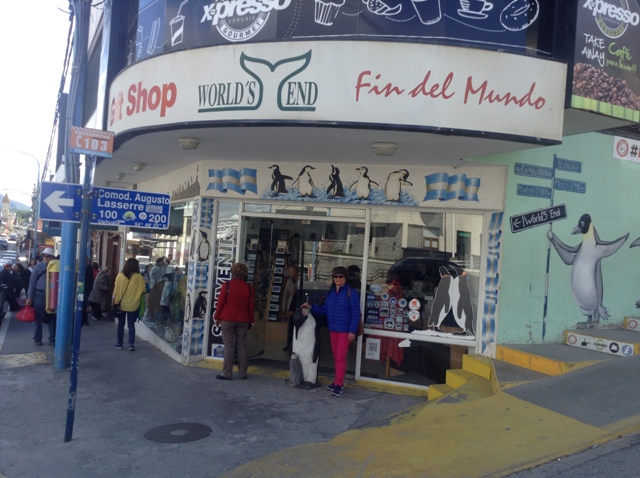



























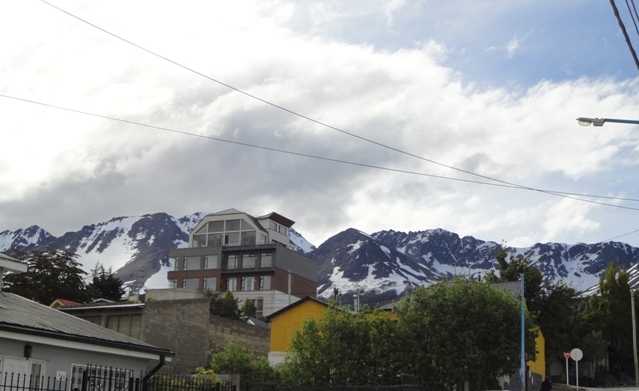





























































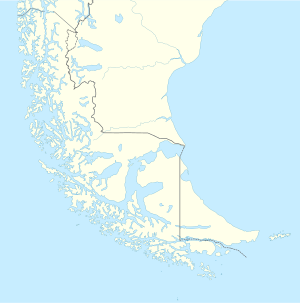







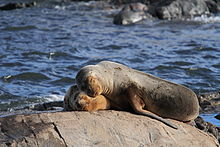

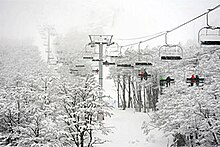

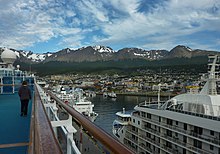






Aucun commentaire:
Enregistrer un commentaire